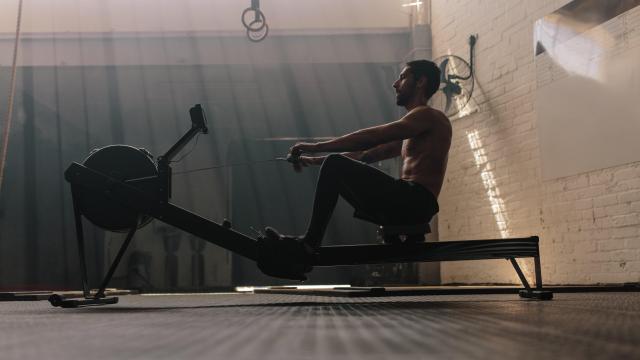Rowers are having a moment. Hydrow seems to be forcefully inserting itself into our Instagram feeds (or is that just mine?), and even Peloton is selling one of them. We can probably credit the Crossfit boxes of the world for the machines’ ubiquity, as rowers provide a brutal workout but also stand up neatly against the wall when you aren’t using them. So is a rower right for you? Let’s take a look.
Rowing is not strength training
But first, I want to bust a big myth: Rowing doesn’t count as strength training. Yes, it asks a lot of your legs and includes movements that mimic a squat, deadlift, and a barbell row. If you aren’t used to these movements, you’ll be sore after your first day. But that doesn’t make them strength training.
A rowing machine can certainly help you build muscle if you currently don’t do any training, but once you get used to the movement, it’s not going to be a major muscle-builder. It’s like running or cycling in that respect: both use your legs, and your legs may be sore after your first session, but runners still need to do their squats, and any movement that you can do enough times in a row to constitute cardio simply does not count as strength training.
What kinds of workouts can you do with a rower?
Rowing is most often used when you want to incorporate an intense interval into a functional fitness workout. These can be short stints of, say, 30 seconds, or you can do a workout like one of these, which have you pushing the pace for minutes at a time.
But you can also row at a low intensity for a longer period of time. With a bit of work on your technique, a leisurely row should feel akin to an easy jog or slow bike ride. Imagine you want to get somewhere by paddling across a lake; unless someone was chasing you, you wouldn’t expect to only sprint across. In short, you can use a rower for steady state or interval cardio, your choice.
Is a rower easy to use?
Once you know what you’re doing, it’s no problem to hop on a rowing machine and use it with the same ease as you would a bike or treadmill. But when you’re new, it can take some time to perfect your technique. Remember that your power stroke uses your legs and then your back and then your arms, and you reset in reverse: arms, torso, legs.
Another common beginner mistake has to do with that 1-to-10 scale of resistance on the side of the wheel. Make sure you’ve set the resistance somewhere around a 3 or 4, which approximates the feel of real water. A 5 can be good for interval workouts, but you should only go outside the 3-5 range if you have a specific reason to do so. (I have gotten this wrong in the past, thinking higher is better. I am smarter now.)
How to choose between rower and a different cardio machine
One of the biggest differences between a rower and a bike or treadmill is that the rower works your full body, not just your legs. If you like the idea of involving more of your body in your cardio workouts, that could be a plus. Another advantage to a rowing machine is that most rowers take up very little space and can tip up vertically when you’re not using them, leaving an even smaller footprint.
On the other hand, the full-body nature of a rowing workout can be a drawback if you have an upper-body injury, even something as minor as torn calluses from another workout. There’s also no way to be truly lazy during a rowing workout — no equivalent to nonchalantly moving the pedals while you scroll Reddit on your phone. If you want a machine that makes you focus, a rower could be a good choice. But if you have a hard time talking yourself into getting on your machine, a bike or treadmill might be more inviting.
Which kind of rower should you get?
Most types of home gym equipment have inspired lively debate: people prefer this brand or that brand, or they’ll tell you what features to look for and argue over whether the cheapest options are good enough or not. There’s much less of that in the rowing world. The cheap rowers suck so the investment in a more expensive one is probably better in the long run.
This hilarious flowchart recommends saving up $1,200 before you are even allowed to work through the rest of the questions. It ends with the C2, of course, although if you enjoy “hobbit-like machinery” it recommends a WaterRower. Whether Peloton’s new offering is able to improve on what’s currently on the market remains to be seen.

Leave a Reply
You must be logged in to post a comment.